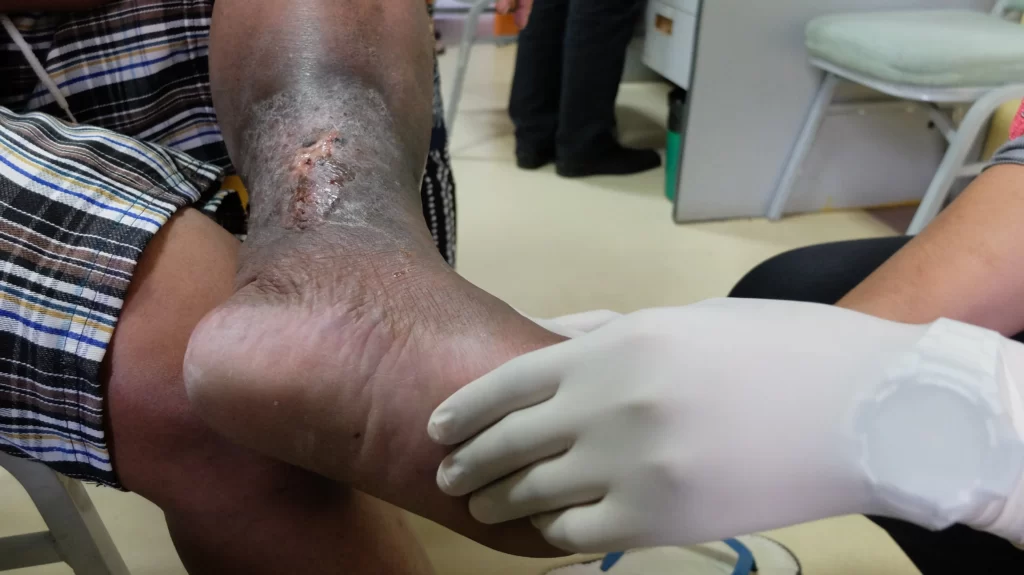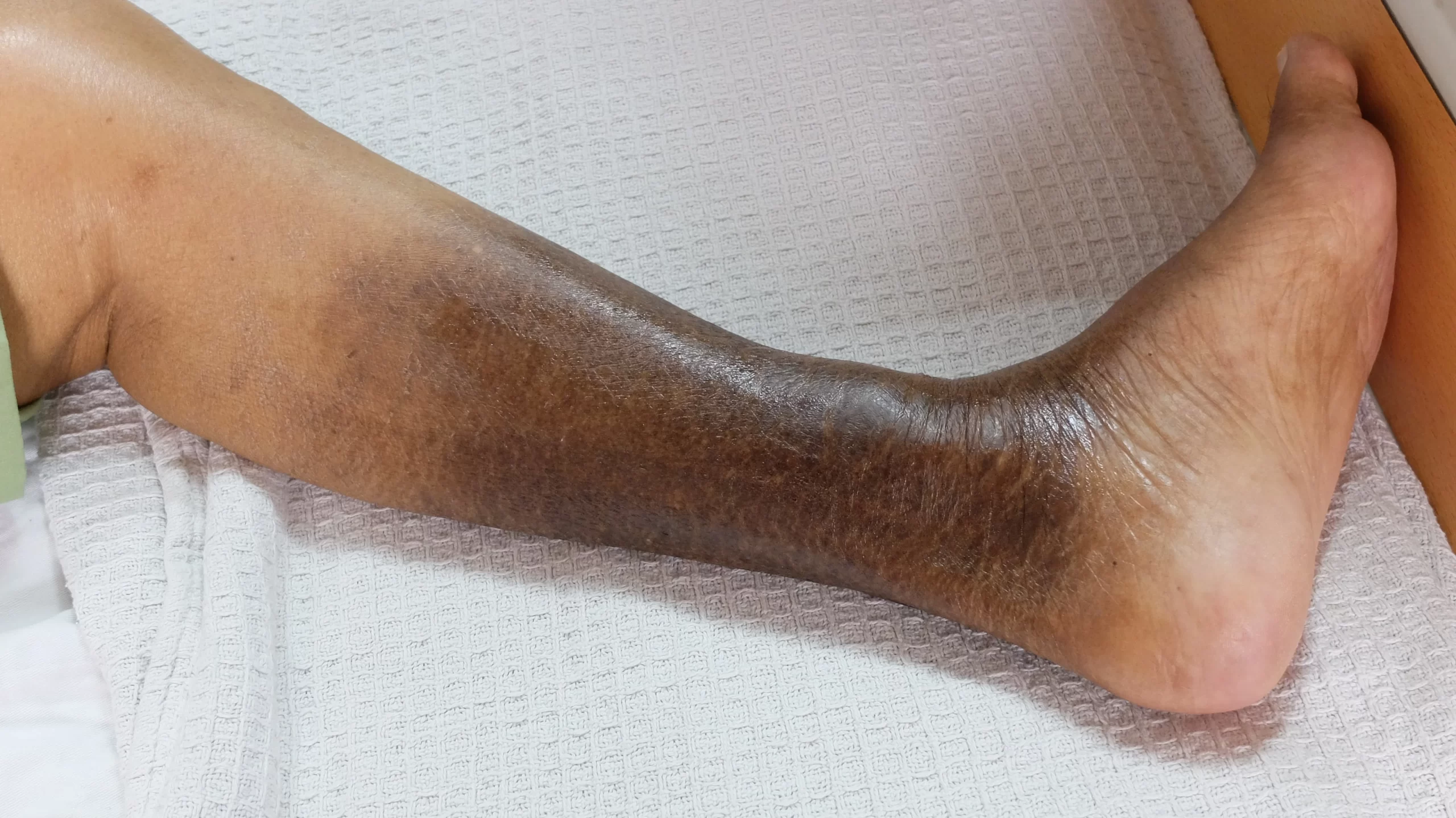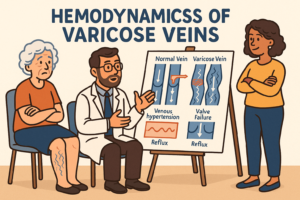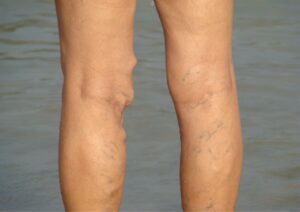
What is Acute Lipodermatosclerosis?
Lipodermatosclerosis is typically a chronic condition that develops over time as a result of long-standing venous disease. However, in some cases, lipodermatosclerosis can present as an acute condition, which may be more severe and have a more acute phase rapid onset.
Acute lipodermatosclerosis is characterized by sudden onset of pain, and redness in the lower leg, often accompanied by fever and other signs of infection.
The skin may appear reddish-purple and may be warm and tender to the touch. In severe cases, blisters or ulcers may develop during the acute phase, which can be painful and may become infected.
Acute lipodermatosclerosis is often associated with an acute exacerbation of underlying venous incompetence, such as a blood clot or infection.
When Do Symptoms of Lipodermatosclerosis Begin?
Symptoms of lipodermatosclerosis usually develop gradually over time and are typically associated with long-standing venous hypertension due to the raise pressure, which is often caused by varicose veins.
The early symptoms of lipodermatosclerosis may include a feeling of heaviness or discomfort in the legs, swelling, and increased pigmentation. As the condition progresses, the skin may become thicker and harder, and may take on a reddish-brown color.
In some cases, the affected tissue may become itchy, painful, or tender to the touch. In severe cases, lipodermatosclerosis can lead to the development of chronic venous ulceration, which are painful open sores that can be difficult to heal.
What is a “champagne bottle leg”?
The term “champagne bottle leg” or inverted champagne bottle refers to a leg that has a narrow or tapered appearance at the ankle and then widens towards the calf, similar to the shape of an inverted champagne bottle.
This can be a sign of venous hypertension, where the veins in the lower leg are not able to properly return blood to the heart due tot he raised pressure, leading to blood pooling and swelling in the lower leg.
The appearance of a “champagne bottle leg” may also be accompanied by other symptoms, such as varicose veins, increased pigmentation, and chronic venous ulceration.
How Is Lipodermatosclerosis Diagnosed?
Lipodermatosclerosis is a disease, typically diagnosed clinically based on a combination of medical history, physical examination, and imaging studies by medical professionals.
Your doctor will first conduct a physical exam, which may involve checking for signs of inflammation and increased pigmentation in the lower legs. They may also ask questions about your symptoms, medical history, and any medications you are currently taking.
Imaging studies, such as ultrasound or venography, may be used to evaluate the extent of venous hypertension and identify any underlying issues with the veins.
What Causes Lipodermatosclerosis?
The exact mechanisms that lead to the development of lipodermatosclerosis are not fully understood, but it is thought that the inflammation and tissue damage caused by venous insufficiency may trigger an immune response, leading to scarring and thickening of the underlying tissues.
Risk factors for developing lipodermatosclerosis include age, obesity, pregnancy, a family history of varicose veins or venous insufficiency, and a history of blood clots or other circulatory disorders.

What are the Complications of Lipodermatosclerosis?
Lipodermatosclerosis can lead to several complications, especially if left untreated or if the underlying chronic venous incompetence is not properly managed. Some of the potential complications of lipodermatosclerosis include:
Venous Ulcers:
Lipodermatosclerosis can increase the risk of developing legs ulcers, which are open sores that can be painful and difficult to heal. These ulcers typically occur on the lower leg and can be a source of infection if left untreated.
Deep Vein Thrombosis (DVT):
Individuals with lipodermatosclerosis are at an increased risk of developing blood clots in the deep veins of the leg, which can be life-threatening if they travel to the lungs.
Cellulitis:
Lipodermatosclerosis can increase the risk of developing cellulitis, which is a bacterial infection that can be painful and potentially serious.
Skin Changes:
The skin changes associated with lipodermatosclerosis, such as hyperpigmentation and hardening of the skin, can be permanent and may cause cosmetic concerns.
Chronic Pain and Disability:
In severe cases, lipodermatosclerosis can cause chronic pain and disability, which can significantly impact a person’s quality of life.
What are the Stages of Lipodermatosclerosis?
Lipodermatosclerosis typically progresses through several stages, each with its own characteristic symptoms and physical findings. The stages of lipodermatosclerosis are:
Stage 1:
Early or mild stage: In this stage, the skin of the lower leg may appear slightly discolored and may feel tight or slightly thickened. The affected area may also feel warm and tender to the touch.
Stage 2: Moderate stage:
In this stage, the skin becomes more visibly discolored, typically taking on a reddish-brown color. The skin may also become more thickened and hardened, and small bumps or nodules may form under the skin. The affected area may be painful or tender to the touch, may be more pronounced.
Stage 3: Severe lipodermatosclerosis:
In this stage, the skin becomes even more thickened and hardened, and may take on a woody or brawny appearance. The affected area may be extremely painful, and the skin may crack or weep fluid. Ulcers may also develop, which can be painful and difficult to heal.
Can Lipodermatosclerosis be Reversed?
While there is no cure for lipodermatosclerosis, it can be managed with appropriate treatment to prevent further damage and alleviate symptoms. In some cases, early intervention can help to slow or even reverse the progression of the condition.
What are the Common Treatments for Lipodermatosclerosis?
The best treatment for lipodermatosclerosis depends on the severity of the condition and the underlying cause. In general, the main goal is to alleviate symptoms, prevent complications, and slow or even reverse the progression of the condition.
Some of the most common treatments for lipodermatosclerosis include:
Compression Therapy:
This involves wearing compression stockings or bandages to improve circulation and reduce swelling in the affected leg.
Medications:
Certain medications, such as diuretics, anti-inflammatory drugs, and antibiotics, may be used to manage symptoms and prevent complications.
Lifestyle Changes:
Regular exercise, weight management, and avoiding prolonged periods of standing or sitting can help to improve circulation and prevent further damage to the veins and surrounding tissues.
Surgery:
In some cases, surgery may be necessary to correct underlying venous insufficiency.
Wound Care:
For patients with venous leg ulcers or ulcer recurrence, proper wound care and the use of topical or oral antibiotics may be necessary to prevent infection and promote healing.
What Are the Modern Treatments for Lipodermatosclerosis?
Lipodermatosclerosis (LDS) and sclerotherapy and endovenous laser treatment (EVLT) are all related to the treatment of chronic venous insufficiency (CVI).
Lipodermatosclerosis is a chronic condition characterized by inflammation, fibrosis, and thickening of the skin and subcutaneous fat of the lower leg, often caused by long-term venous insufficiency.
Treatment of lipodermatosclerosis is aimed at reducing inflammation and preventing progression of the disease, and may include measures such as compression stockings, wound care, and medications.
Sclerotherapy is a minimally invasive medical treatment used for varicose veins and spider veins, in which a solution is injected into the affected vein to cause it to collapse and eventually be reabsorbed by the body.
This treatment can also be used to treat some cases of LDS, particularly when there are associated varicose veins.
EVLT is another minimally invasive treatment for varicose veins that uses laser energy to heat and close off the affected vein, allowing blood flow to be rerouted to healthy veins. Like sclerotherapy, EVLT can also be used to treat some cases of LDS, particularly when there are associated varicose veins.
In summary, while sclerotherapy and EVLT are treatments for varicose veins and can also be used to treat some cases of LDS, the treatment of LDS typically involves a combination of measures aimed at reducing inflammation and preventing progression of the disease, which may include compression therapy, wound care, and medications to improve the long term results.
What is the Difference Between Stasis Dermatitis and Lipodermatosclerosis?
Stasis dermatitis and lipodermatosclerosis are two distinct conditions that can occur as a result of venous hypertension, but they have some differences.
Stasis dermatitis is an inflammatory condition that affects the skin of the lower legs and ankles. It is caused by a buildup of fluid and pressure in the veins, which can lead to swelling, redness, itching, and ache. Over time, the skin may become thin, discolored, and prone to developing open sores or ulcers.
Lipodermatosclerosis, on the other hand, is a more severe form of skin and subcutaneous fat damage that can occur as a result of venous incompetence. It is characterized by changes in the skin and underlying tissues, including thickening, hardening, and discoloration.
The affected area may feel warm to the touch, and small bumps or nodules may form under the skin. In severe cases, chronic lipodermatosclerosis also can lead to the development of venous ulcers due to poor wound healing.
While stasis dermatitis and lipodermatosclerosis can have similar symptoms, they differ in terms of their severity and the extent of the damage.
Stasis dermatitis is generally considered by medical professionals to be a milder form of skin damage, while lipodermatosclerosis is a more advanced and potentially more serious condition that can lead to permanent tissue damage and disability.
Treatment for both conditions typically involves managing the underlying venous insufficiency with measures such as compression therapy, medications to improve circulation and control inflammation, and lifestyle changes such as regular exercise and weight management.
FAQ
There is no one “best” cream for lipodermatosclerosis, as the treatment of this condition typically involves a combination of measures aimed at reducing inflammation and preventing progression of the disease, which may include compression therapy, wound care, and medications.
However, topical medications such as corticosteroids or calcineurin inhibitors may be used to reduce inflammation and improve skin symptoms associated with lipodermatosclerosis.
These medications should only be used under the guidance of a healthcare provider, as they can have potential side effects and may not be appropriate for everyone.
Lipodermatosclerosis (LDS) can cause various types of pain in the affected leg. Some of the most common types of pain associated with LDS include:
Aching: Many people with LDS experience a dull, persistent ache in the affected leg. This pain may be worse after standing or sitting for long periods of time, and may improve with leg elevation.
Burning or itching: Some people with LDS experience a burning or itching sensation in the affected leg.
Skin sensitivity: The skin in the affected leg may become sensitive to the touch, making it painful to wear tight clothing or shoes.
Throbbing: Some people with LDS may experience a throbbing or pulsating sensation in the affected leg.
Shooting or stabbing pain: In some cases, LDS can cause sharp or shooting pains in the affected leg.









